Platinum: «the little silver» of spaniards
“Frog’s gold” – the Queen of metals
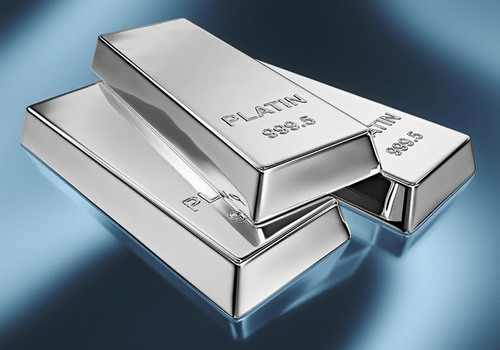 One can’t even list all names that were given to that silver white metal of amazing beauty in the literature of the XVIII century: “frog’s gold”, “rotten gold”, “white gold”. Its heavy grains were found while gold-mining, but the platinum wasn’t treatable, so the precious metal was thrown away with waste rocks. An amazingly delicate appearance of that metal in combination with durability couldn’t be left unnoticeable by the watch companies. One appeared in the famous watch brands’ field of view, today the platinum has become a completely special phenomenon of watchmaking: the platinum wrist watches are a symbol of luxury and fine taste. One can’t even list all names that were given to that silver white metal of amazing beauty in the literature of the XVIII century: “frog’s gold”, “rotten gold”, “white gold”. Its heavy grains were found while gold-mining, but the platinum wasn’t treatable, so the precious metal was thrown away with waste rocks. An amazingly delicate appearance of that metal in combination with durability couldn’t be left unnoticeable by the watch companies. One appeared in the famous watch brands’ field of view, today the platinum has become a completely special phenomenon of watchmaking: the platinum wrist watches are a symbol of luxury and fine taste.
However, before being recognized and in line with the noble and desired metals, the platinum had to pass a long way: from adornment of the Egyptians and “best friend” of European counterfeiters to the most precious and rare metal of the modern jewelry and watch art. In fact, the history of platinum – “the Queen of metals” – starts much earlier than you suppose: the appearance of platinum at the Earth resulted from “Big Bang” that created our universe, according to the legend. It was contained in the meteorites, fallen down on the Earth about two billion years ago, near Africa, inhabited only by protozoa then.
The ancient Egyptians, Incas, medieval alchemists and counterfeiters, Spanish conquistadors, Kings of various epochs and their subjects admired the delicacy and amazing beauty of silver metal. Many items that the history left us are evidences of this admiration.
Hardly there is a man who could keep himself from staring in wonder at a platinum item. But not everyone can afford such item: the platinum of 21st century is a property of wealthy people to emphasize their social status and aristocratic taste.
As for the wrist watches, the use of platinum in watchmaking is quite natural and explicable: apart from a sophisticated and luxurious appearance, this metal is the most solid and durable among the others that couldn’t be but valued by both watchmakers and connoisseurs of lux chronometers.
It’s interesting that the first companies, which used the platinum in manufacture of wrist watches were Cartier, Tiffany, Vacheron Constantin and Patek Philippe.
However, before we start talking about excellent products of these watch companies, let’s take a dive into Ancient Egypt and other civilizations, where the platinum was mentioned for the first time…
First records of platinum
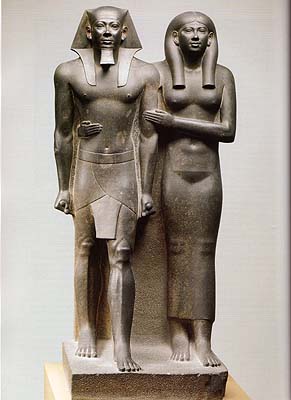 The ancient Egyptian, fascinated by the beauty of “white gold”, brought a gold with platinum inserts from ancient kingdom of Nubia to Egypt for the first time 1200 years ago before Christ. Later in 700 BC the daughter of Thebe’s King, elder great priestess Shipinupet, was buried in Egypt. The priestess is rested in an amazing sarcophagus, adorned with gold and platinum hieroglyphs; near the sarcophagus the archaeologists found a platinum papyrus case. The ancient Egyptian, fascinated by the beauty of “white gold”, brought a gold with platinum inserts from ancient kingdom of Nubia to Egypt for the first time 1200 years ago before Christ. Later in 700 BC the daughter of Thebe’s King, elder great priestess Shipinupet, was buried in Egypt. The priestess is rested in an amazing sarcophagus, adorned with gold and platinum hieroglyphs; near the sarcophagus the archaeologists found a platinum papyrus case.
The South American craftsmen and Inca jewelers also were interested in platinum. According to many archeological researches, 100 years ago before Christ the Inca used platinum for making various ritual items, nose rings and various adornments.
However, since that moment the platinum was lost in the history for almost two millenniums. It got its hour of triumph at the age of Discoveries, in 1590, when the Spanish conquistadors came upon the metal. They found the metal on the territory on modern Columbia and named it “plata” – “platino” that means “little silver” in Spanish.
Here the story of platinum starts for the second time. While mining the gold, the workers also found strange white-grey “nubs”, which were not broken or melted. At first they just threw them away with waste rocks, but soon the strange “nubs” came into use. The European alchemist, for instance, dreamed of creating “the philosopher’s stone” with the help of that desired Spanish “little silver”.
Round-the-world adventures of platinum
 Europe, South America: Europe saw the metal by chance: it was brought as a souvenir. In the middle of XVIII century the Spanish mathematician Antonia de Uoliya brought samples of native platinum from gold mines in Peru: the grains of white metal were not cleaved or melted even at the anvil. It was just an amusing souvenir for Antonio. But soon that “amusing souvenir” caused a lot of scientific disputes: for example, if it is a simple substance or a mix of gold and iron (as the naturalist Buffon considered). So, in 1700 the platinum was finally in the limelight of Europe – an educational center of civilized world. The Europeans started studying and examining the hard-to-cut material. Europe, South America: Europe saw the metal by chance: it was brought as a souvenir. In the middle of XVIII century the Spanish mathematician Antonia de Uoliya brought samples of native platinum from gold mines in Peru: the grains of white metal were not cleaved or melted even at the anvil. It was just an amusing souvenir for Antonio. But soon that “amusing souvenir” caused a lot of scientific disputes: for example, if it is a simple substance or a mix of gold and iron (as the naturalist Buffon considered). So, in 1700 the platinum was finally in the limelight of Europe – an educational center of civilized world. The Europeans started studying and examining the hard-to-cut material.
Many disputes and researches, concerning that metal, finally had to define its place and application field in the human life. But the most interesting fact about platinum was that while the European chemists and naturalists were arguing, the counterfeiters quickly found a practical use: in the middle of XVIII century the platinum was valued two times less than the silver. The practical dealers found out that the density of platinum is high, and it is easy alloyed with gold and silver. So the platinum was added to gold and silver for making adornments and coins.
However, soon the government knew about that and declared war on “platinum evil”. According to the Royal Decree, the civil servants of the mints in Santa Fe and Popayan (Spanish colonies in South America) had to gather all platinum, mined with the gold, and solemnly throw it in the Cauca and Bogota rivers before witnesses.
The law was cancelled only in 1778, when the Spanish government itself started purchasing the platinum at low prices and alloying it with gold of its coins. Although the work of the Sweden scientist Teofil Scheffer played an important role: in 1751 the scientist published his experiments and announced the platinum to be a precious metal. However, the metal kept the loud name “platino”, given by the Spanish conquistadors in the middle of XVI century.
England, Italy: In 1735 the Italian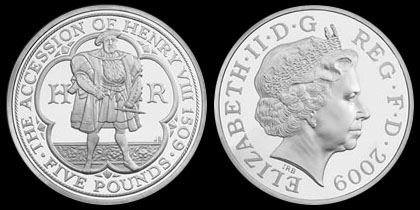 chemist Julius Scaliger discovered one of the most important features of platinum – indecomposability – and proved that the metal is an independent chemical element. However, according to some sources, the Englishman Watson was the first who invented the platinum in 1750. Anyway, as a new element, the platinum was recognized only in two years after the Scheffer’s researches, in 1752. The pure platinum was obtained by the English chemist Wollastone in 1803. chemist Julius Scaliger discovered one of the most important features of platinum – indecomposability – and proved that the metal is an independent chemical element. However, according to some sources, the Englishman Watson was the first who invented the platinum in 1750. Anyway, as a new element, the platinum was recognized only in two years after the Scheffer’s researches, in 1752. The pure platinum was obtained by the English chemist Wollastone in 1803.
When the platinum was taken as a new and separate element, it was used for making the technical items. The first platinum items were plates, wires, crucibles that weren’t perfect. The platinum was used more and more, and the chemists and engineers became interested in it: so, in 1808, the English chemist and engineer, discoverer of rhodium and palladium, Wollastone made a platinum vessel of a pood weight, designed to obtain a concentrated sulphuric acid. Practically at the same time a similar vessel was created in France in 1809.
.jpg) France, Spain: Later “the little silver” appeared within sight of monarch Louis XVI. The French monarch liked the metal so much that he proclaimed the platinum to be the only noble metal, worthy of kings. The personal jeweler of the king – Marc-Etienne Jennet, who crafted some platinum accessories for the king, made a great contribution. As the time told us, those accessories drew the attention of not only Louis XVI: the Spanish King Carlos III didn’t want to be behind of his French “colleague” and in 1788 ordered the craftsman Francisco Alonso to make a platinum cup of 30 cm height that should be presented to the Pope Pius VI. Today the luxurious cup costs $75,000. France, Spain: Later “the little silver” appeared within sight of monarch Louis XVI. The French monarch liked the metal so much that he proclaimed the platinum to be the only noble metal, worthy of kings. The personal jeweler of the king – Marc-Etienne Jennet, who crafted some platinum accessories for the king, made a great contribution. As the time told us, those accessories drew the attention of not only Louis XVI: the Spanish King Carlos III didn’t want to be behind of his French “colleague” and in 1788 ordered the craftsman Francisco Alonso to make a platinum cup of 30 cm height that should be presented to the Pope Pius VI. Today the luxurious cup costs $75,000.
In 1795 in France, elated with revolution, metric weights and measures were created. Marc-Etienne Jennet, who had escaped from Paris earlier, returned to the capital to work on a kilogram platinum sample. And no wonder that metal indeed was chosen for making a sample: the platinum is the most resistant metal to damages and oxidation that guaranteed the originality of sample even in several centuries. The original platinum cylinder of 39 mm height and 39 mm diameter is still kept in the International Bureau of Weights and Measures in Paris.
The favorite jeweler of Louis XVI achieved a high craftsmanship in platinum working by means of lime and alkali and left his trace in that art. He alloyed native platinum with arsenic out of lime and alkali. Then the excessive arsenic was annealed, resulting in malleable metal that could be processed. Such working method widened the range of manufactured items from platinum, as a result the demand as well as the price on the metal increased, owing to the new researches of that metal. However, the true value of the metal hadn’t been defined yet.
Platinum “boom” and start of platinum industry
The end of 1800s can be called a true “platinum” period: 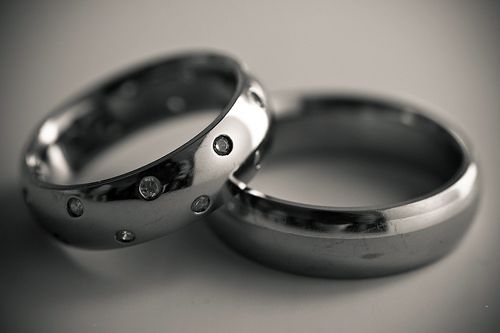 all kings and queens, tsars and imperators, maharajahs and padishahs of that time wore platinum accessories. all kings and queens, tsars and imperators, maharajahs and padishahs of that time wore platinum accessories.
Carlos IV, the King of Spain, gave an order to create the famous “platinum” room in his palace. The room, finished by expensive woods and encrusted with platinum, embodies the magnificence and luxury of the epoch.
In the beginning of next century the famous jeweler Louis Cartier, whose name is still a symbol of jewelry craftsmanship of the highest and perfect quality, set a new epoch in the history of platinum use. His platinum jewelries revealed all the potential of that metal to the society for the first time. Cartier used the platinum with diamonds to reveal and emphasize all the beauty and play of jewels. Cartier remained to be matchless in working with platinum. The King of England, Edward VII proclaimed Louis to be “the king of jewelers and the jeweler of kings”.
The next discovery completely affirmed the success of platinum and defined the start of platinum industry: in 1924 the German geologist Hans Merensky found the largest platinum field. The place near Johannesburg in South Africa became the “place” of platinum.
Soon the platinum won “the dream factory”: when in 1930s the film by Frank Capra “Platinum blonde” with Jean Harlow starring became popular and Marlene Dietrich and Jean Harlow started wearing the platinum jewelries, it 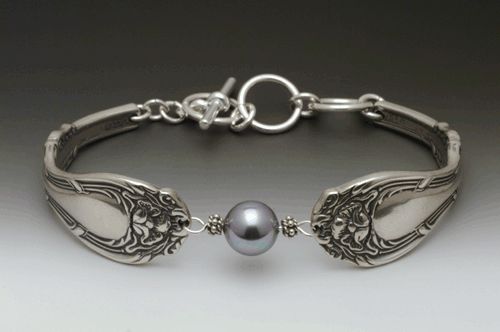 became clear that the platinum is a new symbol of luxury and shine. became clear that the platinum is a new symbol of luxury and shine.
After that the platinum and platinum accessories became practically obligatory at significant events among influential people. So, in 1936 the King of England Edward VIII abdicated to marry Wallis Simpson. During the coronation of George VI, who came to the throne instead of Edward, the wife of George VI – the Queen of England – Elisabeth was crowned by a platinum diadem with the famous diamond “Koh-i-noor”, and Edward and Wallis were entitled as the Duke and Duchess of Windsor and exchanged the platinum rings of Cartier. The new Duchess of Windsor – a collector and expert of jewelries – became an admirer of platinum and even claimed it to be the best supplement for evening dresses.
During the world war the platinum acquired strategic importance. The fashion ladies had to cede their desires: the use of platinum in jewelry was strictly banned. However, that fact indeed made the platinum the most popular essential metal in jewelry industry during the after-war years. And as if compensating the platinum “abstention” during the world war in 1947 an amazing platinum jewelry exhibition was held in New-York under the title “White rush”: the white color and “white” metal are at the peak of popularity again.
Soon the platinum became the most popular and prestigious metal for making wedding rings. So, in 1967 at the double-ring ceremony Elvis Presley and Priscilla Ann Beaulieu wore the platinum wedding rings.
Platinum shoes and platinum dresses
One of the greatest events of the platinum use was the creation of shoes for Cinderella..jpg) The Tokyo jeweler Tanaka Kikinzoku Kogyo used two kilograms of precious metal for making the precious shoes. The fairy shoes for Cinderella were presented in 1997 in Great Britain at the exhibition “Ideal home”. The woman who fitted the fairy shoes was awarded a gift (unfortunately for women, those shoes have never been given as a present). The Tokyo jeweler Tanaka Kikinzoku Kogyo used two kilograms of precious metal for making the precious shoes. The fairy shoes for Cinderella were presented in 1997 in Great Britain at the exhibition “Ideal home”. The woman who fitted the fairy shoes was awarded a gift (unfortunately for women, those shoes have never been given as a present).
The next extraordinary use of metal became the creation of platinum fabric: it turns out that it’s possible to create several kilometers of thinnest precious thread out of two kilograms of platinum.
The Italian couturier Domo Adami created an unprecedented dress, which knocked the fashion society dead: the luxurious dress was completely embroidered with platinum threads! The Scotland supermodel Niv Jeggings presented the dress to the fascinated audience. The dress costs over $163,000.
Some facts from chemistry
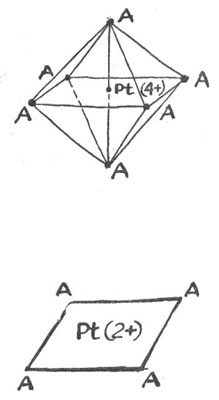 The platinum is considered to be one of the rarest and heaviest metals; its average grade in the crust makes up 5.107% by weight. This metal isn’t decomposed in alkalis and acids (except for aqua-regia), that’s why it is referred to the group of the most inert metals. Today “the little silver” is not just a precious metal, owning of which makes your social status higher. The platinum of new millennium is one of the most important materials of technical progress. It’s like a salt for cooking: you need a little of it, but you can’t do without it. The various scientific, technical and industrial fields can’t exist without platinum. As this metal is simply irreplaceable in many modern devices and machines. The platinum is one of the main catalysts of modern chemical industry. The platinum is considered to be one of the rarest and heaviest metals; its average grade in the crust makes up 5.107% by weight. This metal isn’t decomposed in alkalis and acids (except for aqua-regia), that’s why it is referred to the group of the most inert metals. Today “the little silver” is not just a precious metal, owning of which makes your social status higher. The platinum of new millennium is one of the most important materials of technical progress. It’s like a salt for cooking: you need a little of it, but you can’t do without it. The various scientific, technical and industrial fields can’t exist without platinum. As this metal is simply irreplaceable in many modern devices and machines. The platinum is one of the main catalysts of modern chemical industry.
The delicate beauty of this silver-white metal surprisingly combines with its main features: solidity, durability and wear resistance. Today the platinum takes one of the leading places among the noble metals. The platinum is quite rare metal that is one of the determining factors of its high price. The largest fields of platinum are in the South Africa: practically 80% of world mining. Russia and Canada are the next in the list. The native platinum is a quite rare phenomenon: it is found 30 times rarer than the native gold. Such rarity has become the reason the platinum is a symbol of luxury and wealthy. And, of course, watch industry couldn’t leave such metal without attention. The wear resistance can be named one of the main features of this metal: any metal is worn out while finishing, lose some of its part, except the platinum. This metal is out of time power. The first companies, which presented the platinum watches, were the biggest brands: Tiffany, Cartier, Vacheron Constantin and Patek Phillipe. At first they made just jewelries: diamonds mounted in platinum, then the combination of platinum and diamonds became classical.
Platinum today
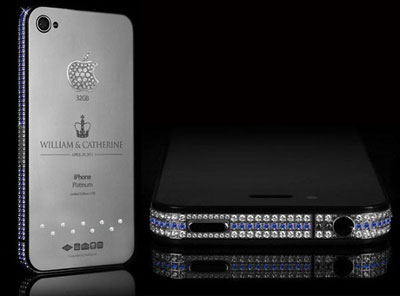
Today the world resources of platinum are giving out. “The little silver” refers to the category of nonrenewable Earth resources. The modern technologies and science require more and more “white” metal: its price rises each year, only a few people can afford platinum adornments. According to the forecasts of some experts, in nearest future the platinum and platinum jewelries will be withdrawn from free sale and the platinum adornments will become a family treasure.
However, in spite of everything, the platinum is a choice of aristocrats, celebrities, showing off on red carpets, respectable businessmen and modern monarchs and members of their families.
The creation of chronometers couldn’t pass over the platinum with its rich history. The platinum wrist watches indeed are expensive and luxurious and designed for those who can afford it and who is an expert in it. So, we’ll continue talking about platinum watches, as we’ve promised in the beginning…
Platinum Blue Sensation watch from Grieb&Benzinger: the heaviest platinum wrist watch in the world
 The German watch company “Grieb&Benzinger” is famous for skeletonization and guilloching of unique wrist watches. The brand founders – German watchmakers Johan Benzinger and German Grieb – worked long time for such famous brands as IWC, Chronoswiss, Tourneau and Faberge. The talented watchmakers could found the brand on the base of accumulated experience. The German watch company “Grieb&Benzinger” is famous for skeletonization and guilloching of unique wrist watches. The brand founders – German watchmakers Johan Benzinger and German Grieb – worked long time for such famous brands as IWC, Chronoswiss, Tourneau and Faberge. The talented watchmakers could found the brand on the base of accumulated experience.
Each model of wrist watches, created on the south of Germany in old castle, where Grieb&Benzinger is situated, is a true masterpiece of haute horlogerie. The watches are based on complicated old movements of legendary watchmakers of 1880-1920s: Vacheron Constantin, Lange&Sohne, Patek Philippe. The craftsmen of Grieb&Benzinger fully recreated the old complicated movements and refined them with the help of classic technologies: engraving, skeletonizing, manual guilloching and, finally, coating with blue platinum. The workshop of Grieb&Benzinger resembles a technical museum: antique instruments combine with special modern technologies. The complicated movements turn into masterpieces of watchmaking here indeed. The watches of Grieb&Benzinger are mainly issued in a single piece that is undoubtedly worthy of such wrist watches.
The model “Platinum Blue Sensation” became a real sensation. Today these wrist watches are the heaviest ones at the world watch market and presented in one piece. The heaviest platinum watches in the world - Grieb&Benzinger Platinum Blue Sensation.
The case diameter makes up 49 mm. But the most notable feature of this watch is its weight – over 150 grams. This model presents the heaviest platinum watch in the world. Platinum Blue Sensation is made in a single piece; its price is about 235.000 euro (including VAT).
However, the main advantages of this model are not its outstanding size and weight that just make it a worthy part of Guinness Book of Records, but not of watch industry. The specific feature of Platinum Blue Sensation is its movement from the personal collection of restorer German Grieb – vintage movement of Patek Philippe for Tiffany. This unique antique movement is made in 1889 specially for the famous jewelry house of Tiffany in New York.
The modification and restoration of watch movements with a minute repeater always require the finest craftsmanship from watchmakers. The technical modification of bridges and plates of complicated split-chronographs, skeletonization and guilloching in the turn require much more time and attention. The restoration of unique movement took many hours of hard and meticulous handwork. The finest guilloching of bridges and plate added the tiniest openings of 1/20 mm size, necessary for improved movement. The movement was dissembled several times, adjusted and assembled again to present the owner a perfect work of each detail.
Platinum watches “Collection Excellence Platine” from Vacheron Constantin
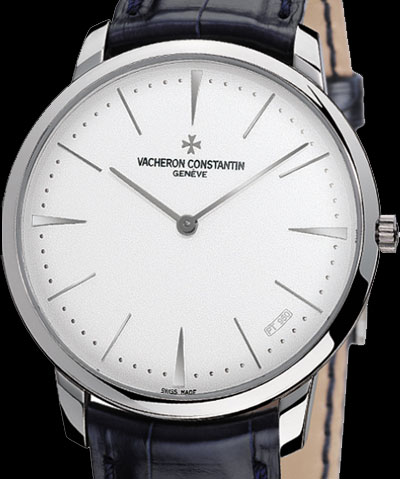 The watch company “Vacheron Constantin” is one of the oldest Swiss watch companies. The development of this watch company is characterized by a specific epoch in the history of Geneva watchmaking. The case is that in the XVI-XVII centuries the organization of protestants-Calvinists, promoting an ascetic way of life by fighting against any show of luxury, had a great influence in Geneva. However, the ban of beautiful and expensive things seems to spur up the people’s bent for owing luxurious things. The fans of beauty and shine had to realize their desires somehow: as a result, the watchmakers turned their fervor and passion to the creation of wrist watches, which became a specific loophole in that situation. It’s interesting that almost a forth of twenty thousand people living in Geneva in the middle of XVIII century was occupied in the watch industry one way or another. According to the modern researchers, 800 masters worked in Geneva – it meant that each of them had his own workshop and brand. Jean-Marc Vacheron, a young mechanic, was one of them: having inherited a workshop from his father at the age of 24, Jean-Marc first drew upon a credit of 1000 silver pounds and concluded a contract with Genevan watch manufactory. Under that contract the workshop of Vacheron was obliged to supply the manufactory with complicated watch movements. Having paid off its debts within 10 years, the company kept on working on its own. The second part of the company’s name appeared thanks to Francois Constantin, who became a significant person in the history of company. Due to him the company emerged from a crisis under monarchy. Being a qualified trader and passionate traveler, Constantin was capable to embody the most unexpected and original ideas for sale and promotion of wrist watches. Soon, due to an effective work with Jean-Marc Constantin became his partner and in 1819 the company was renamed “Vacheron Constantin”. The watch company “Vacheron Constantin” is one of the oldest Swiss watch companies. The development of this watch company is characterized by a specific epoch in the history of Geneva watchmaking. The case is that in the XVI-XVII centuries the organization of protestants-Calvinists, promoting an ascetic way of life by fighting against any show of luxury, had a great influence in Geneva. However, the ban of beautiful and expensive things seems to spur up the people’s bent for owing luxurious things. The fans of beauty and shine had to realize their desires somehow: as a result, the watchmakers turned their fervor and passion to the creation of wrist watches, which became a specific loophole in that situation. It’s interesting that almost a forth of twenty thousand people living in Geneva in the middle of XVIII century was occupied in the watch industry one way or another. According to the modern researchers, 800 masters worked in Geneva – it meant that each of them had his own workshop and brand. Jean-Marc Vacheron, a young mechanic, was one of them: having inherited a workshop from his father at the age of 24, Jean-Marc first drew upon a credit of 1000 silver pounds and concluded a contract with Genevan watch manufactory. Under that contract the workshop of Vacheron was obliged to supply the manufactory with complicated watch movements. Having paid off its debts within 10 years, the company kept on working on its own. The second part of the company’s name appeared thanks to Francois Constantin, who became a significant person in the history of company. Due to him the company emerged from a crisis under monarchy. Being a qualified trader and passionate traveler, Constantin was capable to embody the most unexpected and original ideas for sale and promotion of wrist watches. Soon, due to an effective work with Jean-Marc Constantin became his partner and in 1819 the company was renamed “Vacheron Constantin”.
The creations of Vacheron Constantine set the highest standards in the watch industry: that company indeed was the first to create an antimagnetic wrist watch. Having survived both world wars, it managed to collaborate with all big entrepreneurs of that time.
After the World War II the company was irrefutably successful: each year the company presented innovative excellent watch models, developing the style and specific features of Vacheron Constantin brand, at the world watch market. The craftsmen of the company applied the platinum for the first time in the middle of XIX century and have never stopped using the noble metal since that time.
In September, 2006, Vacheron Constantin presented a unique collection of wrist watches “Collection Excellence Platine”, made of platinum, in Moscow. The watch collection was called by the experts “a highest level of platinum watch evolution”.
The collection is released by limited edition, including four completely unique lines with its specific details. Collection Excellence Platine is a kind of following step after the exposition of twelve historic platinum watches from collection of Heritage House “Vacheron Constantin”, carried out by the company at special events. The watches of this luxurious collection are combined with the platinum, of course: the case and buckle are made of 950 platinum. The dial is worth of a special attention: its special surface is achieved by means of sandblasting.
The “Patrimony Contemporaine” line is issued in the number of 150 pieces. The elegant chronometers of this line are provided with the manual movement, caliber 1400, on 20 jewelries. The frequency is 28.000 a/h. The classic wrist watches are a reflection of perfect sophistication, specific for Vacheron Constantin in the first half of XXI century. A strict restrained dial, made in a minimalistic style, shades the luxurious noble metal. The power reserve is 40 hours; the water resistance – 30 meters. The rest lines of platinum collection are designed in the same luxurious style: Skeleton Minute Repeater (15 timepieces), Skeleton Minute Repeater (75 timepieces) and Quantieme Perpetuel Retrogradant Openface. Each model is provided with a gift box from grey maple.
Cartier sensuality, embodied in platinum: “Cartier Tortue XL Tourbillon Chronomonopoussoir” and “Rotonde de Cartier À Grande Complication” watches
“The jeweler of kings and the king of jewelers” – the famous jeweler of 19th century, Cartier was given that name by Edward VII. The talent for creating unique jewelry and watch pieces in a special recognizable style during one and a half century turned Cartier into a symbol of delicate luxury and expressive dignity.
The wrist watch of Cartier is an idea, which is embodied in noble metals as a result of long work, disputes and meetings. The power of endless creation process – motion of ideas, words, gestures, dozens of drafts and sketches and hundreds of tiny components – Cartier is like a mill, where the masters get the flour and make a puffy pie of haute horlogerie.
According to the watchmakers, the creation of one pair of wrist watches takes in average about 18 months. At the same time the company designs about 200 projects, not including special exclusive orders.
One of the first manufactories of the company appeared in 1972 in La Chaux-de-Fonds: in the new millennium the small department has changed into one of the largest and self-sufficient Swiss watch enterprises. Today it’s not easy to count the wrist watches, created by Cartier at that and other manufactories.
In 2001 the company united 5 separate manufactories under the roof of production site in La Chaux-de-Fonds. A team of 1 000 craftsmen, specializing in more than 50 watch and jewelry professions, gathered there. The manufactory was divided into several industry zones: one zone is devoted to new developments in mechanics of wrist watches, another one – to manufacture of wrist watches. 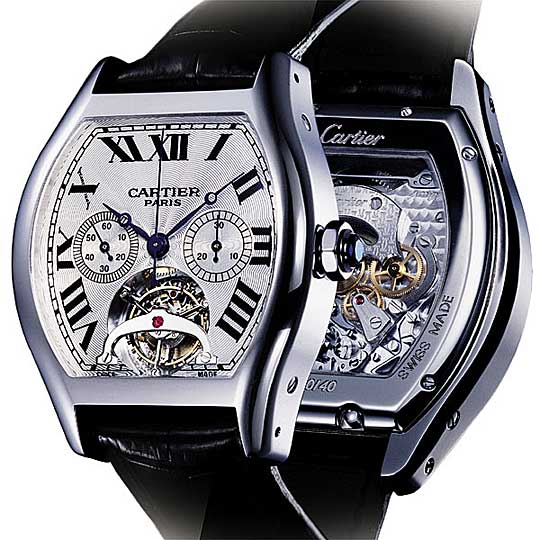
The history of independent watch manufactory “Cartier” started with women wrist watches, representing sophisticated bracelets with small mounted chronometers.
Cartier Tortue XL Tourbillon Chronomonopoussoir
The wrist watch “Cartier Tortue XL Tourbillon Chronomonopoussoir (Ref.W 1545751)” – a model from the legendary manufactory – is the embodiment of Cartier classics in platinum case “Tortue”. The watch became a pleasant surprise for the company’s fans: the unique movement combines the tourbillon with one-button chronograph. The movement was created by Renaud&Papi’s special order. The brand C-shaped tourbillon bridge also became a notable and original feature of the movement. The hour and minute scales are adorned with Roman numerals; the crown is provided with sapphire cabochon.
The case, crafted in 950 platinum, is the main design accent. Its sizes – 48x39 mm, its height – 7,65 mm. The guilloched dial is made of 18-carat gold. The platinum C-shaped tourbillon bridge points to the legendary jewelry and watch house, which the chronometer belongs to. The hands are made of blued steel. The dial is covered with mineral glass, the back case is sapphire.
The wrist watch “Tortue XL Tourbillon Chronomonopoussoir” is provided with hand-wound movement, tourbillon Cartier 9431, based on Renaud&Papi; the number of jewelries – 40. The frequency – 21.600 alterations per hour, the power reserve – 72 hours, the plates and bridges are adorned by hand. The water resistance – 30 meters. The strap is made of natural alligator leather and provided with 950 platinum buckle. The watches are issued in a limited number of 40 pieces. The chronometer costs 180.000 euro.
Rotonde de Cartier À Grande Complication(1).jpg)
But the platinum “passion” of Cartier wasn’t limited by only that model. The platinum always was a “minion” of Cartier. The first Cartier wrist watches were issued in 1888, having won the connoisseurs of elegant luxury and perfect style and the whole world. The first watches the company produced in series were women wrist watches “Tonneau”, made in nontraditional barrel shape and from platinum; a sapphire or delicate pearl played the role of crown.
The famous collection “Collection Privee Cartier Paris” distinguishes among the rest by its original feature: it includes the outstanding wrist watches of “Cartier” jewelry and watch house. The wrist watch “Rotonde de Cartier À Grande Complication” became a worthy member of the collection, specific by its platinum case. Rotonde de Cartier À Grande Complication represents a perpetual calendar, tourbillon and one-button chronograph with 8-day power reserve. The platinum case with brand crown and back case, made of sapphire and encrusted with sapphire cabochon, is its design peculiarity. An unusual tourbillon bridge, made in the form of Cartier letter and situated at “9” hours”, also became an extraordinary design decision.
The creators of that chronometer integrated the week day indicator into the power reserve indicator. However, the designers haven’t limited themselves to that: the year indicator is designed in original striped style and represents four strips between hand indicators of months and days at “1” hour. You can see all four strips in leap year. The company has produced only 10 pieces of collectable chronometer that only emphasizes the peculiarity of these watches.
“Opus Two” collection from Harry Winston
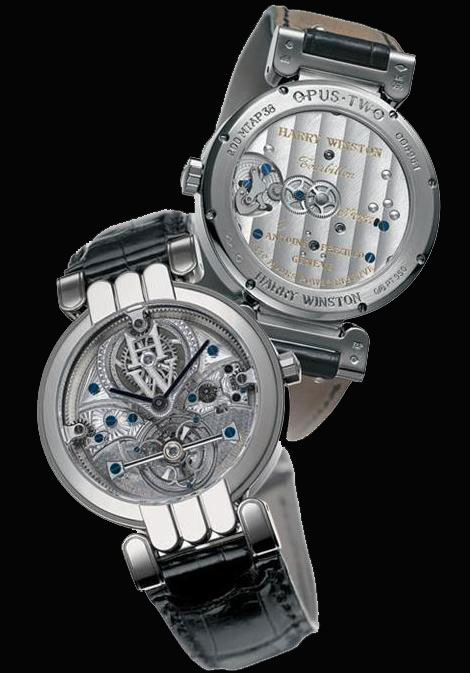 The watch company “Harry Winston” is one of those companies, which won the status of exclusively expensive jewelry watch manufacturer for only wealthy people – experts in luxurious chronometers. The company’s moto – “only exclusive” – laid down the basis for stunning popularity. According to some experts, such success owed to the creation of brand founder: platinum mount, creating 3D jewelries. In the beginning of new millennium, according to the watchmaker – head of the project, Maximilian Busser, the company started carrying out a grandiose project, aimed at creating “unprecedented watch masterpieces, reviving a taste of creative liberty”. The watch company “Harry Winston” is one of those companies, which won the status of exclusively expensive jewelry watch manufacturer for only wealthy people – experts in luxurious chronometers. The company’s moto – “only exclusive” – laid down the basis for stunning popularity. According to some experts, such success owed to the creation of brand founder: platinum mount, creating 3D jewelries. In the beginning of new millennium, according to the watchmaker – head of the project, Maximilian Busser, the company started carrying out a grandiose project, aimed at creating “unprecedented watch masterpieces, reviving a taste of creative liberty”.
The main concept of the project, started in 2001, was the collaboration with independent watch masters, who would create a new unique limited model each year: one model for each craftsman. The “Opus” line became an amazing trip to the world of high technologies and innovations, to the world of revolutionary chronometers.
Opus Two, issued in 2002, became notable thanks to the platinum and unique movement. That line became an outstanding example of engineering decisions and noble metals fascinating combination, having proved once again the highest reputation of “Harry Winston” house. The platinum watches “Opus Two” are a team-work of Harry Winston and famous Genevan watchmaker. The unique collection is released in a limited edition of 11 pieces. The case is crafted in 950 platinum.
The model represents a minute tourbillon – one of the most complicated movements in the history of haute horlogerie. The watches from “Opus Two” line are a design of genius watchmaker Antoine Preziuso. Antoine is a member of professional academy AHCI, which members are able to create any movement. Antoine has been close to watch movements since his childhood: his father was a watchmaker in one of Rolex subsidiaries.
Preziuso was born in 1957 in Geneva. His diploma work became a notable fact in his biography: Antoine had to make a complication for the standard wrist watch “Rolex Oyster”. But then the future famous craftsman didn’t know that in many years in 2003 the wrist watch “Rolex Oyster” with his retrograde indicator of date and Lunar phase indicator would be sold for USD19,396 at the auction “Sotheby's”.
So, Antoine Preziuso won incredible popularity. Today he has orders from the largest world brands. For example, the talented watchmaker created wrist watches with perpetual calendar and minute repeater for Swiss company “Breguet”. However, as the watchmaker says, he was always obsessed with tourbillons. This movement has inspired Antoine to create the “Opus Two” line. The watchmaker admitted that he was inspired by New-York boutique “Harry Winston”, situated at the crossroads of 5th Ave and 56th street: the New-York’s life, impetuous, very specific, business and tumultuous, became the source of inspiration for making the collection. The watchmaker adorned the dial of Opus 2 with picture of arch, situated above the famous boutique entry, as a symbol of his inspiration.
Antoine Preziuso and Maximilian Busser, the creators of Opus Two, presented amazing chronographs, limited by 24 pieces.
Antoine is so meticulous that he always uses gloves while working: he thinks that human skin can damage the details. The watchmaker admits that he tries to hold his breath, as breathing may influence the movement negatively. Preziuso created completely special tourbillons for Opus Two – “remontage mysterieux”, designed especially for that collection. The frequency of movement makes up 21.600 alterations per hour. The skeletonized dial is made by hand. The power reserve made up 110 hours.
In one of his interviews Antoine pointed that he pursued one object while making watches: to create “live watches” with tourbillons as their hearts. According to the watchmaker, the dial would also draw the attention, like a celebrity’s face: “the movements themselves are the actors in these watches”.
And, of course, the talented watchmakers achieved their aim: the “Opus Two” collection became specific thanks its extraordinary movement, combined with noble platinum framing.
An unusual perpetual calendar became a specific feature of that line: if you turn the watch, you can see the platinum cover with two apertures. One is for week days, another – for date. The button at “3” hours let you opening the white gold dial with three scales: the retrograde dials at “12” and “6” hours show the date and week days, and the scale at “9” hour shows the month.
As the watch creators pointed, most of the time was spent on designing the wheel systems, responsible for hands moving and back case calendar work. The diameter of traditional round dial is 38 mm. Because of complicated movement, the case turned to be a bit thicker than it was in previous lines. The company created a separate model with diamonds in a single copy for admirers of special luxury.
Platinum watches of Ulysse Nardin: a circus on your wrist
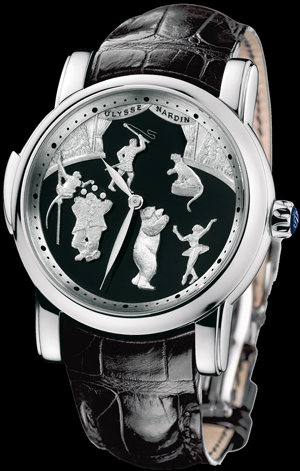 Founded in 1846 in Le Locle, during 160 years the watch company “Ulysse Nardin” has only proved its perfect quality that stroke the watch connoisseurs in the beginning of its work. The “Ulysse Nardin” watches are like vine from an old vineyard: the brand and taste are familiar to everyone, but each bottle is a special variation, new taste and tone. So are the watches: the novelty and originality of each chronometer of the company is proved by unique movement and original design of each model, designed at its own manufactory. The designing of company are “on the move”: they are always updated, supplemented with new complications, design decisions. Founded in 1846 in Le Locle, during 160 years the watch company “Ulysse Nardin” has only proved its perfect quality that stroke the watch connoisseurs in the beginning of its work. The “Ulysse Nardin” watches are like vine from an old vineyard: the brand and taste are familiar to everyone, but each bottle is a special variation, new taste and tone. So are the watches: the novelty and originality of each chronometer of the company is proved by unique movement and original design of each model, designed at its own manufactory. The designing of company are “on the move”: they are always updated, supplemented with new complications, design decisions.
The late CEO of company, Rolf Schneider often pointed in his interviews that Ulysse Nardin was not just a lux watch company: it was very important for a creative team to realize that their work was a creative agreed process of the best watchmakers, artists and designers. After the death of Rolf Schneider, his wife Chai Schneider, who took master’s degree of engineering technology at the Royal University of Great Britain, inherited the helm. “My aim is to keep an innovative spirit and develop the vision of Rolf Schneider” – said Chai Schneider after her husband death.
A friendly atmosphere and well-organized work of the stuff provides the company with a possibility to fascinate its fans constantly with the craziest and boldest ideas. A constant strive for innovations and originality of each model, distinguishing from the previous one, is the specific feature of the company’s products. During many years the company has been realizing all the bold and incredible innovative ideas. The creation of extraordinary accessories has become the main concept of making Ulysse Nardin watches. The creative “generator” of the company, Ludwig Oechslin, follows just this concept.
The wrist watches “Circus Minute Repeater” were first presented at the world watch fair in Switzerland “BaselWorld 2004”. Then the model “Circus Minute Repeater” was just a prototype sample, which still drew much attention. The watches were presented in two variants: 18-carat gold and platinum.
The black onyx dial, adorned with pattern of circus arena, became an original design decision for Circus Minute Repeater watches. However, it’s not just a design whim: the creators provided the minute repeater with special lever, which sets the figures going. Each figure’s move defines a certain time interval. So, an hour strike is accompanied with monkey and clown, playing ball; each quarter of an hour a trainer whips a tiger; each minute the tiger stretches his paw; a bear bows before a ballerina means that the movement is wound. The designers have created by hand a small world on your wrist that is really amazing.
The 42 mm diameter case is crafted in platinum, the dial – in natural black onyx. The combination of shimmering platinum and matt elegant onyx emphasizes delicately the original dial, covered with sapphire glass.
The water resistance of Circus Minute Repeater reaches 30 meters, the power reserve – 48 hours, the strap is made of natural leather and provided with folding buckle.
The “Circus Minute Repeater” collection is released in a limited edition of 30 models – each of them will become an original accessory, worthy of admiration.
To be continued ...
|


